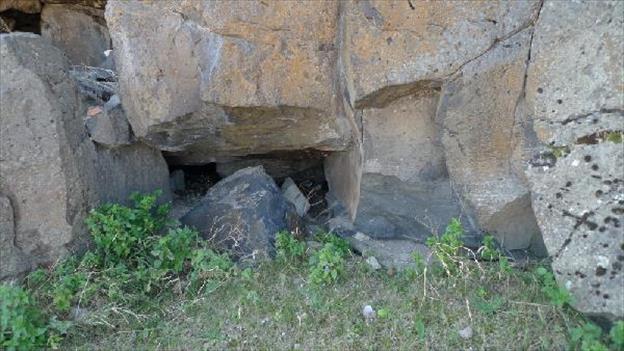
Ruins of the Erebuni fortress
After the unification of the Nairi states by Arame (858 BC–844 BC), historic Armenia known to Assyrians as Urartu became one of the mighty states of the Ancient East. Among the earliest and biggest towns of historic Armenia there was Erebuni situated on Arin-berd hill (the south-eastern outskirt of what is now Yerevan), a major administrative and economic center of the northern part of the country. According to the Khorkhor cuneiform record and two other identical records found in the citadel, Erebuni was built by Argishti I in 782 B. C. (this date is considered that of the foundation of Yerevan). In honour of founding the city, a painted figurine of an armed warrior was made, with a cuneiform inscription on a bronze pedestal. This confirms the signifcance of Erebuni is an important military stronghold of the country. The name Yerevan itself is derived from Erebuni.
The fortress of Erebuni was skillfully build in the tradition of the kingdom of Van. Town neighbourhoods were situated at the foot of a nearly 65-m high hill crowned with the citadel which was the architectural dominant of the surrounding locality. The citadel commanded a full view of the Ararat plain with its settlements and the main roads leading to Erebuni. The configuration of the hill top determined the triangular shape of the citadel’s plan.
Another element of variety was a six-column portico which stood left of the road and accentuated the entrance to the citadel. The portico was painted with colorful frescoes, and the stairway which led up to it was flanked with bronze figures of winged oxen with human heads. The citadel comprised palaces, houses of worship and service premises situated at various levels, depending on the hill surface, and interconnected by stairways. The main entrance way led to the central yard which was reserved for all sorts of ceremonies and for the parades of the personal guards of Argishti I and of the fortress’ garrison. One of the frescoes showed a large scene of hunting, with a nobleman driving in a chariot accompanied by leopards.
In the south-western part of the yard there was the temple of god Khaldi – an oblong large hall with an auxiliary room and a staircase leading to the roof of the tower, and an open 12-column portico, with columns in double rows, where the garrison was probably drawn up. The walls are lined with benches for notables and, at the left end wall, there is an altar for sacrifices. The temple was richly ornamented. Its walls were painted with colourful representations of human figures and gods, with geometrical and floral ornaments. Of special interest is the representation of god Khaldi standing on a lion, with a warder in his left hand and with a horned tiara on his head; it is similar to the bas-relief representation of god Teisheba in Adildzhevaz and many others known in the art of Urartu.
An opening over the credence altar served to let in daylight and draw the altar smoke out. There was another credence altar which stood outside the temple, in the middle of the peristylar yard. The interior and exterior walls of the building were painted sky-blue. Next to the temple there were service premises including two wine stores with enormous (up to 600 litres) jars for wine used in sacrifice offering ceremonies.
Cuineform inscriptions, cut not only on the stone walls but also on the column bases, say that shortly upon being completed, the palace was expanded. Argishti had new premises, organically connected with the fortress layout, added to its south-eastern side.
Successive Urartian kings made Erebuni their place of residence during their military campaigns against northern invaders and continued construction work to build up the fortress defences. Kings Sarduri II and Rusa I also utilized Erebuni as a staging site for new campaigns of conquest directed towards the north. In the early sixth century the Urartian state became a vessel of the Achaemenian Empire. The strategic position that Erebuni occupied did not diminish, however, becoming an important center of the satrapy of Armenia. Despite numerous invasions by successive foreign powers, the city was never truly abandoned and was continually inhabited over the following centuries, eventually branching out to become the city of Yerevan.









